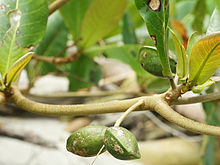Terminalia catappa
| Terminalia catappa | |
|---|---|

| |
| Scientific classification | |
| Kingdom: | Plantae |
| Clade: | Tracheophytes |
| Clade: | Angiosperms |
| Clade: | Eudicots |
| Clade: | Rosids |
| Order: | Myrtales |
| Family: | Combretaceae |
| Genus: | Terminalia |
| Species: | T. catappa
|
| Binomial name | |
| Terminalia catappa | |
| Synonyms[2] | |
|
List
| |
Terminalia catappa is a large tropical tree in the leadwood tree family, Combretaceae, native to Asia, Australia, the Pacific, Madagascar and Seychelles.[1] Common names in English include country almond, Indian almond, Malabar almond, sea almond, tropical almond,[3] beach almond[4] and false kamani.[5]
Description
The tree grows to 35 metres (115 feet) tall, with an upright, symmetrical crown and horizontal branches. The fruit is corky and light and dispersed by water. As the tree gets older, its crown becomes more flattened to form a spreading, vase shape. Its branches are distinctively arranged in tiers. The leaves are large, 15–25 cm (6–9+3⁄4 in) long and 10–14 cm (4–5+1⁄2 in) broad, ovoid, glossy dark green, and leathery. They are dry-season deciduous; before falling, they turn pinkish-reddish or yellow-brown, due to pigments such as violaxanthin, lutein, and zeaxanthin.
The trees are
The species epithet is based on its Malay name Ketapang.[7][8]
Distribution and habitat
The tree has been spread widely by humans, so the native range is uncertain. It has long been naturalised in a broad belt extending from Africa to northern Australia and New Guinea through southeast Asia and Micronesia into the Indian subcontinent. More recently, the plant has been introduced to parts of the Americas. Until the mid-20th century, the tree had been used extensively in Brazilian urban landscaping, since being a rare case tropical deciduous, their fallen leaves would give a "European" flair to the street. This practice is currently abolished, and the "amendoeiras" are being replaced by native, evergreen trees.
Cultivation and uses
T. catappa is widely grown in
The wood is red and solid, and has high water resistance; it has been used in Polynesia for making canoes. In Tamil, almond is known as nattuvadumai.
The leaves contain several
Keeping the leaves in an aquarium may lower the pH and heavy-metal content of the water.[citation needed] It has been used in this way by fish breeders for many years, and is active against some parasites and bacterial pathogens.[12] It is also believed to help prevent fungus forming on the eggs of the fish.[citation needed] While common in hobby fishkeeping, this use of catappa leaves is not used in commercial aquaculture.
Gallery
-
Inflorescence
-
Foliage and immature inflorescences
-
Fruits at various stages of ripeness: one cut open to reveal the edible kernel within the hardmesocarpsurrounding the fibrous inner layers
-
Tree canopy on Sand Island, Midway Atoll
-
In winter
References
- ^ . Retrieved 19 November 2021.
- ^ "The Plant List: A Working List of All Plant Species".
- ^ "Terminalia catappa L." Germplasm Resources Information Network. Agricultural Research Service, United States Department of Agriculture. Retrieved 3 July 2016.
- PMID 25412525.
- ^ A.K. Kepler. Trees of Hawaii Kottamba.
- ^ Dr. D. Burger Hzn "Seedlings of species of Some Tropical Trees and Shrubs Mainly of Southern Asia, Centre for Agricultural Publishing and Documentation (1972) page 75
- ^ Stuhlmann, Franz (1909). Deutsch Ost Afrika. Band X. Beitrage zu Naturgeschichte von Ostafrika. Berlin: Dietrich Reimer. p. 122.
- ^ Hynnersley, C.W.S. (1913). Noctes orientales. Being a selection of essays read before the Straits Philosophical Society between years 1893 and 1910 (Criticism). Singapore. p. 183.
{{cite book}}: Unknown parameter|agency=ignored (help)CS1 maint: location missing publisher (link) - ISBN 9780910690027.
- )
- ^ Hnawia E, Hassani L, Deharo E, Maurel S, Waikedre J, Cabalion P, Bourdy G, Valentin A, Jullian V, Fogliani B. "Antiplasmodial activity of New Caledonia and Vanuatu traditional medicines". Pharm Biol. 2011 Apr; 49(4): 369-76.
- .
External links
 Media related to Terminalia catappa at Wikimedia Commons
Media related to Terminalia catappa at Wikimedia Commons- Indian almond leaves- Website devoted to Indian almond leaves in folk medicine, modern medicine and aquariums
- More Ketapang Info- Blog on ketapang leaves






